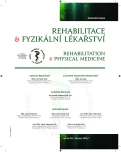Using Dance in Parkinson's Patients Treatment
Authors:
D. Pánek; V. Tupá; D. Pavlů; J. Čemusová
Authors‘ workplace:
Fakulta tělesné výchovy a sportu UK, Katedra fyzioterapie, Praha
vedoucí katedry doc. PaedDr. D. Pavlů, CSc.
Published in:
Rehabil. fyz. Lék., 20, 2013, No. 1, pp. 28-34.
Category:
Original Papers
Overview
The review discusses the possible impact of dance therapy in patients suffering from the Parkinson's disease. From the many classical dances, the reviewed studies chose Argentinian tango which, according to the review's authors, has the most beneficial effects on the motoric behavior of Parkinson's patients. Reviewed results were split into four groups according to the type of research work: original experiment, review study, comparative study and non-controlled study. A positive impact of dance therapy is indicated by most studies which, subsequently, recommend this type of supportive rehabilitation therapy.
Keywords:
Parkinson disease, physiotherapy, dance, therapy
Sources
1. AMBLER, Z.: Neurologické poruchy ve vyšším věku. Základní principy jejich farmakoterapie. Praha, Triton, 2000, 192 s., ISBN 80-7254-116-1.
2. EARHART, G.: Dance as therapy for individuals with Parkinson disease. European Journal of Physical Rehabilitation Medicine, roč. 45, 2009, č. 2, s. 231–238.
3. FEDERICI, A., BELLAGAMBA, S., ROCCHI, M. B.: Does dance-based training improve balance in adult and young old subjects? A randomized controlled trial. Aging Clinical and Experimental Research, roč. 17, 2005, č. 5, s. 385–389.
4. HACKNEY, M. E., KANTOROVICH, S., EARHART, G. M.: A study on effects of Argentine tango as a form of partnered dance for those with Parkinson’s disease and the healthy elderly. American Journal of Dance Therapy, roč. 29, 2007a, č. 2, s. 109–127.
5. HACKNEY, M. E., EARHART, G. M.: Effects of dance on balance and gait in severe Parkinson’s disease: A case study. Disability and Rehabilitation, roč. 32, 2010, č. 8, s. 679–684.
6. HACKNEY, M. E., EARHART, G. M.: Effects of dance on gait and balance in Parkinson’s disease: A Comparison of partnered and non-partnered dance movement. Neurorehabilitation and Neural Repair, roč. 24, 2010, č. 4, s. 384–392.
7. HACKNEY, M. E., EARHART, G. M.: Effects of dance on movement control in Parkinson’s disease: A comparison of Argentine tango and American ballroom. Journal of Rehabilitation Medicine, roč. 41, 2009, č. 6, s. 475–481.
8. HACKNEY, M. E., EARHART, G. M.: Effects of tango on functional mobility in Parkinson’s disease: A preliminary study. Journal of Neurologic Physical Therapy, roč. 31, 2007b, č. 4, s. 173–179.
9. HACKNEY, M. E., EARHART, G. M.: Short duration, intensive tango dancing for Parkinson’s disease: An uncontrolled pilot study. Complement therapies in medicine, roč. 17, 2009, č. 4, s. 203–207.
10. HAMZA, T. H., PAYAMI, H.: The heritability of risk and age at onset of Parkinson’s disease after accounting for known genetic risk factors. Journal of Human Genetics, roč. 55, 2010, č. 4, s. 241–243.
11. McKinley, P., JACOBSON, A., LEROUX, A., BEDNARCZYK, V., ROSSIGNOL, M., FUNG, J.: Effect of a community based Argentine tango dance program on functional balance and confidence in older adults. Journal of Aging and Physical Activity, roč. 16, 2008, č. 4, s. 435–453.
12. RASCOL, O., GOETZ, C., KOLLER, W., POEW, W., SAMPAIO, C.: Treatment interventions for Parkinson’s disease: an evidence based assessment. The Lancet, roč. 189, 2002, č. 359, s. 1589–1598.
13. ROTH, J., SEKYRKOVÁ, M., RŮŽIČKA, E.: Parkinsonova nemoc. Praha, Maxdorf, 2009, 222 s., ISBN 978-80-7345-178-3.
14. RŮŽIČKA, E, ROTH, J.: Diagnostický a léčebný standard. Parkinsonova nemoc. Praha, Psychiatrické centrum, 1998, 72 s., ISBN 80-85121-19-0.
15. SACCO, K., CAUDA, F., CERLIANI, L., MATE, D., DUCA, S., GEMINIANI, G. C.: Motor imagery of walking following training in locomotor attention. The effect of ‘the tango lesson’ NeuroImage, roč. 32, 2006, č. 3, s. 1441–1449.
16. TANNER, C. M., OTTMAN, R., GOLDMAN, S. M., ELLENBERG, J., CHAN, P., MAYEUX, R., LANGSTON, J. W.: Parkinson’s disease in twins: An etiologic study. Journal of American Medical Association, roč. 281, 1999, č. 4, s. 341–346.
17. TUPÁ, V.: Alternativní fyzioterapeutické postupy u Parkinsonovy nemoci. Diplomová práce, FTVS UK. Obhájená 2012.
18. TUPÁ V., PÁNEK, D., PAVLŮ, D., ČEMUSOVÁ, J.: Alternativní terapeutické postupy u pacientů s Parkinsonovou nemocí. Rehabil. fyz. Lék., roč. 20, 2013, č. 1, s. 37–44.
19. VAN DEN EEDEN, S. K., TANNER, C. M., BERNSTEIN, A. L., FROSS, R. D., LEIMPETER, A., BLOCH, D. A., NELSON, L. M.: Incidence of Parkinson’s disease: variation by age, tender and race/ethnicity. American Journal of Epidemiology, oč. 157, 2003, č. 11, s. 1015–1022.
20. Westbrook, B. K., McKibben, H.: Dance/movement therapy with groups of outpatients with Parkinson's disease. American Journal of Dance Therapy, roč. 11, 1989, č. 1, s. 27–38
21. Westheimer, O.: Why dance for Parkinson's disease. Topics in Geriatric Rehabilitation, roč. 24, 2008, č. 2, s. 127–140.
Labels
Physiotherapist, university degree Rehabilitation Sports medicineArticle was published in
Rehabilitation & Physical Medicine

2013 Issue 1
- Hope Awakens with Early Diagnosis of Parkinson's Disease Based on Skin Odor
- Deep stimulation of the globus pallidus improved clinical symptoms in a patient with refractory parkinsonism and genetic mutation
Most read in this issue
- Remote Postural Effects Influencing M. Biceps Brachii
-
Swallowing Disorders In Children - Interdisciplinary Cooperation Physiotherapists with Clinical Speech Pathologist
(Part 1 - Diagnostics) - Issues of the Locomotor System Injuries Among Golf Players
- Facilitated Expectoration by Airway Clearance Techniques in Patients with Significantly Weakened Respiratory Muscles
